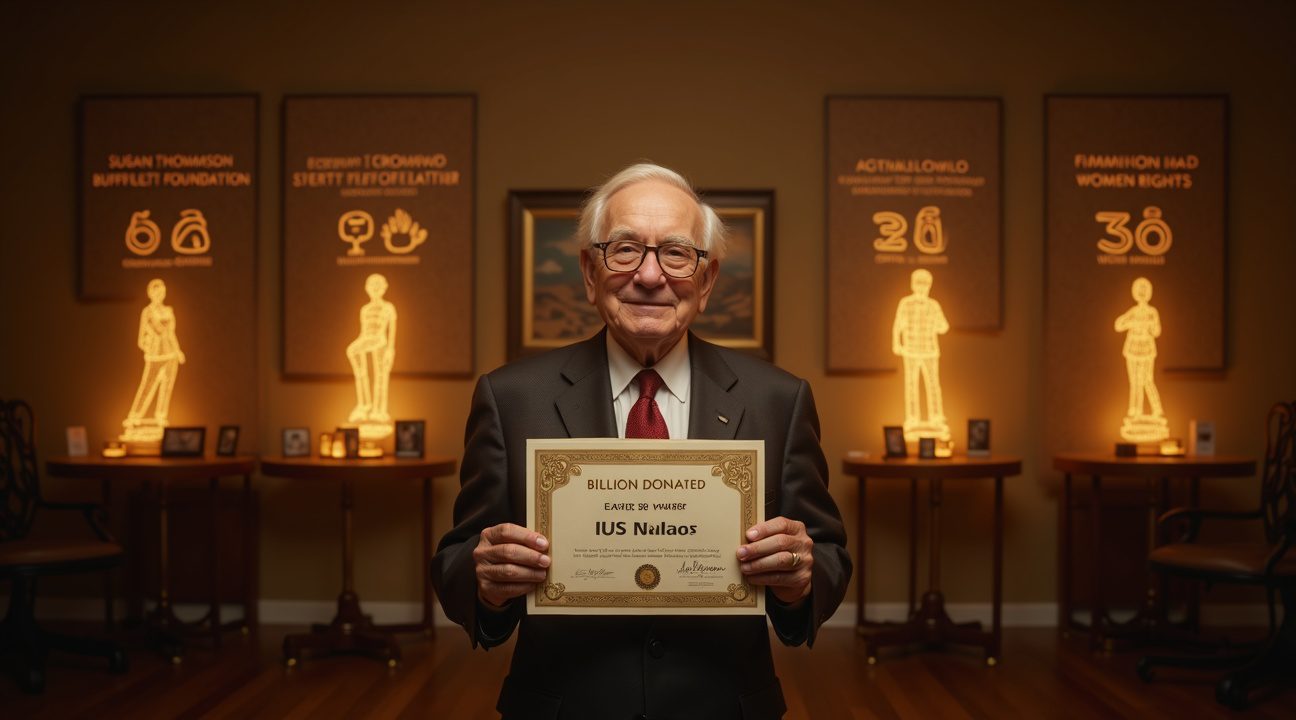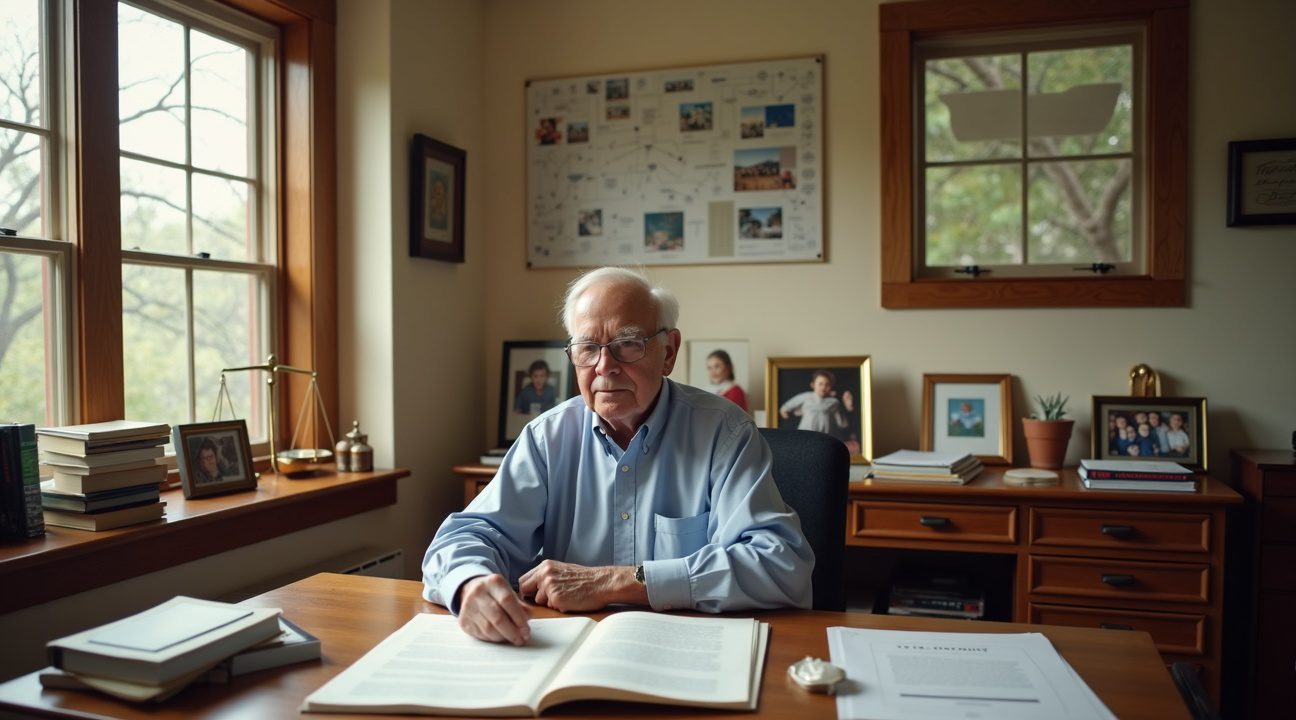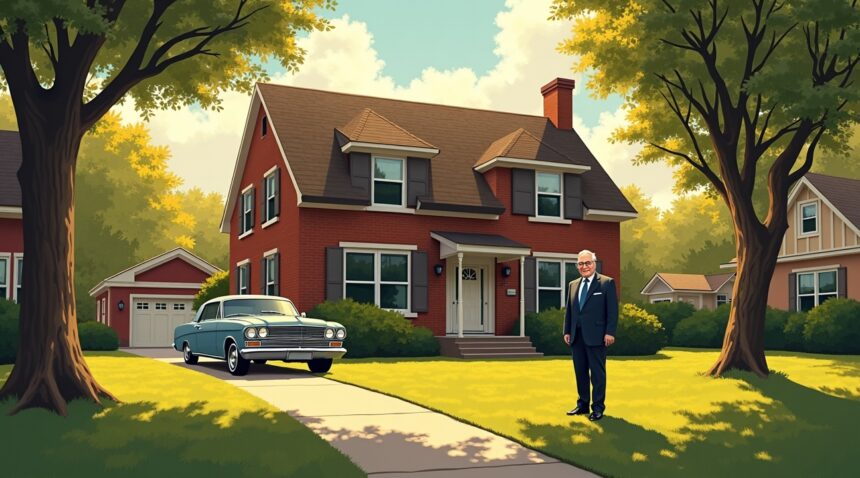Warren Buffett’s extraordinary approach to wealth demonstrates that true success doesn’t require luxury living. The 94-year-old billionaire continues to reside in the same modest Omaha home he purchased for $31,500 in 1958. He maintains his commitment to donate 99 percent of his estimated $149 billion fortune to charity. His philosophy combines practical frugality with unprecedented philanthropic generosity. He has already given away over $50 billion through systematic annual donations while establishing a transparent estate plan that will distribute nearly all remaining wealth within a decade of his death.
Key Takeaways
- Modest Living: Despite his $149 billion net worth, Buffett still lives in the same 6,280-square-foot Omaha home he bought in 1958 for $31,500, which he ranks as his third-best investment after his two wedding rings.
- 99% Wealth Pledge: Buffett has committed to giving away 99 percent of his fortune through The Giving Pledge initiative, with his children required to distribute all funds within 10 years to prevent wealth from sitting idle in endowments.
- Active Philanthropy: He has already donated over $50 billion to charitable causes, including a $1.1 billion contribution in 2024 distributed primarily through the Susan Thompson Buffett Foundation and his children’s foundations.
- No Family Dynasty: His children will receive sufficient but limited inheritances, as Buffett believes in merit-based success rather than creating multi-generational wealth dynasties.
- Complete Transparency: His estate plan will be publicly available for inspection, deliberately avoiding complex offshore structures or “imaginative trusts” to ensure accountability and clarity in his philanthropic intentions.
A 31,500 Dollar House That Became a Billionaire’s Best Investment
Warren Buffett’s relationship with 5505 Farnam Street in Omaha, Nebraska began as a simple rental arrangement in the mid-1950s. He paid just 175 dollars monthly to live in what would eventually become one of his most cherished investments. The 5-bedroom, 2.5-bathroom home spans 6,280 square feet, providing ample space for what would become decades of family memories and financial success.
The Oracle of Omaha made the decision to purchase the property in 1958 for 31,500 dollars. This modest sum, equivalent to approximately 329,505 to 336,700 dollars in today’s purchasing power, secured him a permanent place to call home. Financial experts often marvel at how this simple real estate transaction would become such a significant part of Buffett’s personal investment philosophy.
The Investment That Keeps Giving Returns
Current real estate appraisals place the home’s value between 1.2 and 1.5 million dollars, representing substantial appreciation over the decades. However, Buffett’s perspective on this investment transcends mere financial metrics. He consistently ranks the purchase as his third-best investment ever, placing it behind only his two wedding rings in terms of overall value and satisfaction.
The billionaire’s assessment of his home’s worth extends far beyond market valuations. He frequently emphasizes how the memories created within those walls and the happiness experienced over more than six decades of residence constitute the true return on his investment. This outlook reflects his broader investment philosophy that focuses on long-term value rather than short-term gains.
Buffett’s decision to remain in the same home for over 65 years demonstrates his commitment to practical living despite his enormous wealth. While many billionaires acquire multiple mansions and luxury properties, he continues to find contentment in the same neighborhood where he first established roots as a young investor. The home serves as both a symbol of his humble beginnings and a testament to his belief that happiness doesn’t require extravagant living arrangements.
The property’s appreciation from 31,500 dollars to over a million represents more than just successful real estate timing. It embodies Buffett’s investment approach of buying quality assets and holding them for extended periods. Just as he applies patience and long-term thinking to his stock investments, his home purchase reflects the same disciplined strategy that has made him one of history’s most successful investors.
Why the World’s Fifth-Richest Person Chooses to Live in the Same House for 66 Years
Warren Buffett’s decision to remain in his 1958 Omaha home defies every expectation people have about billionaire lifestyles. With a current net worth estimated at 149 billion dollars, the Oracle of Omaha could easily afford any mansion or estate collection imaginable. Instead, he’s chosen to stay put in the same modest house he purchased decades ago for $31,500.
The billionaire’s reasoning centers on a simple philosophy: he has everything he needs right where he is. Buffett has repeatedly emphasized the sentimental value this home holds, representing decades of family memories and personal milestones. Unlike other ultra-wealthy individuals who accumulate multiple properties across different continents, Buffett finds contentment in his unpretentious Nebraska residence.
A Home That Reflects True Values
Walking through Buffett’s home reveals a space that prioritizes comfort and function over ostentation. Visitors describe comfortable, functional furniture that serves its purpose without unnecessary luxury. Family photos line the walls, creating warmth that no expensive art collection could replicate. The minimalist yet cozy design speaks to a man who understands that happiness doesn’t correlate with square footage or price tags.
This approach extends beyond simple frugality—it represents a deliberate choice about what matters most. While other billionaires pursue flashy acquisitions, Buffett demonstrates that wealth doesn’t require display. His home serves as a daily reminder that success can coexist with humility.
The Philosophy Behind the Choice
Buffett’s housing decision reflects his broader investment philosophy applied to personal life. He believes that too often, a vast collection of possessions ends up possessing its owner. This insight drives his resistance to lifestyle inflation despite his extraordinary financial success. Rather than allowing wealth to complicate his life, he’s maintained the same living situation that served him well before becoming one of history’s most successful investors.
The practical benefits extend beyond philosophy. Staying in his original neighborhood keeps Buffett connected to his roots and the community that shaped him. He can walk to his favorite restaurant, maintain longtime friendships, and avoid the isolation that often accompanies extreme wealth. This grounding helps him stay connected to the everyday experiences that inform his business decisions and personal values.
The 149 Billion Dollar Giveaway: Buffett’s Ultimate Philanthropic Plan
Warren Buffett’s commitment to giving away virtually his entire fortune represents one of the most extraordinary philanthropic pledges in history. I find his approach particularly remarkable because it goes beyond simply writing checks—it fundamentally reshapes how billionaires think about wealth distribution and social responsibility.
The Oracle of Omaha formalized his commitment in 2006 through The Giving Pledge, an initiative he co-founded with Bill and Melinda Gates. This groundbreaking program encourages wealthy individuals to pledge at least half their fortunes to charitable causes. Buffett didn’t just meet this threshold; he completely shattered it by committing to give away more than 99 percent of his wealth.
When Buffett passes away, approximately 149 billion dollars will flow into a charitable trust managed by his children. This staggering sum could fund entire government departments or transform countless lives across the globe. His decision reflects a deep understanding that accumulated wealth should serve humanity rather than create dynasties.
Strategic Distribution and Time Constraints
Buffett’s philanthropic strategy includes several key requirements that ensure maximum impact:
- His children must disburse all funds within 10 years of receiving them
- No money can go to endowments that might preserve capital indefinitely
- All donations must focus on immediate, active philanthropy addressing current needs
- The trust structure prevents wealth from sitting idle in perpetuity
The 10-year disbursement requirement stands out as particularly strategic. Rather than allowing his fortune to generate income indefinitely, Buffett wants immediate action on pressing social issues. This timeline creates urgency and prevents the money from becoming trapped in bureaucratic processes that might dilute its impact.
His explicit rejection of endowments reveals a preference for solving today’s problems rather than creating permanent institutions. Many wealthy philanthropists establish endowments that generate annual income while preserving principal. Buffett takes the opposite approach, believing that current suffering demands immediate solutions rather than perpetual funding mechanisms.
The children who will oversee this massive responsibility—Howard, Peter, and Susan—have already demonstrated their commitment to philanthropy through their own charitable work. Their father’s trust in their judgment reflects years of watching them navigate complex social issues with wisdom and compassion.
This approach contrasts sharply with traditional wealth transfer strategies that focus on preserving family fortunes across generations. Market trends often influence how billionaires structure their estates, but Buffett’s plan prioritizes social impact over financial preservation.
The Giving Pledge initiative has attracted over 230 billionaires from 28 countries since its inception. Buffett’s leadership in this movement demonstrates how individual actions can inspire widespread cultural change among the ultra-wealthy. His decision to live modestly while planning such an enormous giveaway reinforces the authenticity of his commitment.
The scale of Buffett’s planned donation dwarfs most countries’ annual budgets and could theoretically address multiple global challenges simultaneously. Climate change, poverty, education, and healthcare could all receive transformative funding from this single source. However, the success of these efforts will depend heavily on how effectively his children identify and support high-impact organizations.
Buffett’s rejection of creating a permanent family foundation in favor of a time-limited trust reflects his belief that future generations should earn their own way rather than managing inherited wealth. This philosophy extends beyond philanthropy into his broader views about meritocracy and social mobility.
The 149 billion dollar figure represents not just money, but decades of compound growth from patient investing. Buffett’s ability to generate such wealth through disciplined value investing makes his decision to give it away even more significant. He’s essentially transferring the fruits of one of history’s most successful investment careers directly to charitable causes.

Already Given Away 50 Billion Dollars and Counting
Warren Buffett’s commitment to philanthropy extends far beyond promises and pledges. As of 2024, the Oracle of Omaha has donated more than 50 billion dollars to charitable causes through his ongoing annual contributions, demonstrating that his dedication to giving runs as deep as his investment acumen.
At age 94 in 2024, Buffett continued his generous streak with a substantial 1.1 billion dollar donation consisting entirely of Berkshire Hathaway stock. This latest contribution showcases his unwavering belief that wealth should serve a greater purpose than personal accumulation. The donation’s structure reveals careful planning and personal values, with the majority flowing to the Susan Thompson Buffett Foundation, named after his late wife.
Strategic Distribution Across Family Foundations
Buffett’s approach to charitable giving reflects both strategic thinking and family involvement. The remaining portions of his 2024 donation were distributed equally among three foundations, each receiving 300 million dollars:
- The Sherwood Foundation, managed by his daughter Susan
- The Howard G. Buffett Foundation, overseen by his son Howard
- The NoVo Foundation, led by his son Peter
Each foundation operates under the guidance of one of his three children, ensuring that his philanthropic vision continues through the next generation. This structure allows for diverse charitable approaches while maintaining family oversight and personal connection to the causes being supported.
Buffett’s philosophy centers on the belief that true value lies in giving rather than accumulating wealth. His actions consistently reinforce this principle, as he continues to transfer significant portions of his fortune to causes that can make meaningful differences in people’s lives. The billionaire’s approach stands in stark contrast to many wealthy individuals who focus primarily on wealth preservation and accumulation.
The scale of his giving becomes even more remarkable when considering that these donations represent ongoing commitments rather than one-time gestures. Buffett has maintained this pattern of substantial annual giving for years, steadily reducing his personal wealth while increasing the resources available to charitable organizations. His methodical approach to philanthropy mirrors the same disciplined thinking that made him one of the world’s most successful investors, except now those skills serve humanitarian rather than financial goals.
This track record of giving provides concrete evidence that Buffett’s pledge to donate 99 percent of his fortune isn’t merely aspirational rhetoric but an active, ongoing process that has already reached the halfway mark.

No Family Dynasty: Why Buffett’s Children Won’t Inherit His Fortune
Warren Buffett’s approach to wealth transfer stands in stark contrast to traditional billionaire inheritance patterns. I find his philosophy refreshing in an era where many ultra-wealthy families create multi-generational dynasties that can perpetuate inequality for centuries.
The Merit-Based Philosophy
Buffett has repeatedly stated his belief that children should earn their own success rather than coast on inherited wealth. He famously advocates for giving children “enough money so that they would feel they could do anything, but not so much that they could do nothing.” This principle drives his decision to limit direct inheritance to his three children – Howard, Peter, and Susan – while directing the bulk of his estimated $118 billion fortune to charitable causes.
The Oracle of Omaha doesn’t view this as punishment for his children. Instead, he sees it as the ultimate gift of independence and self-determination. His children have received substantial amounts during his lifetime and will continue to benefit from trust funds, but these sums represent a tiny fraction of his total wealth. Each child leads productive lives in their chosen fields:
- Howard in farming and conservation
- Peter in music composition
- Susan in nonprofit work
Safeguarding Charitable Intent Through Succession Planning
Recognizing that his children may not outlive the distribution timeline for his charitable giving, Buffett has demonstrated remarkable foresight in his estate planning. He’s appointed three younger successors to serve as contingency trustees for his charitable foundation. While he hasn’t publicly named these individuals, this backup plan ensures his philanthropic vision survives regardless of family circumstances.
This systematic approach reflects Buffett’s business acumen applied to personal wealth management. Just as he wouldn’t leave Berkshire Hathaway without succession planning, he refuses to leave his charitable commitments vulnerable to unforeseen events. The structure guarantees that 99 percent of his fortune will reach charitable organizations even if his children can’t personally oversee the distribution process.
Buffett’s stance on inherited wealth aligns with other prominent philanthropists like Bill Gates, who’ve signed the Giving Pledge. However, his commitment goes beyond mere charitable giving — it represents a fundamental rejection of aristocratic wealth concentration. By choosing merit over inheritance, Buffett sends a powerful message about personal responsibility and social equity that extends beyond financial markets into broader societal values.

A Transparent Legacy Built on Integrity
Warren Buffett’s estate planning philosophy stands as a stark contrast to the complex financial structures many billionaires employ. I find his commitment to transparency particularly refreshing in an era where wealthy individuals often shield their affairs behind layers of offshore entities and intricate trust arrangements. Buffett has explicitly stated that his estate plan will be available for public inspection, ensuring complete transparency about how his vast fortune will be distributed.
Clear Structure Without Hidden Complexity
The billionaire investor has deliberately avoided what he calls “imaginative trusts” or foreign entities that might obscure the true nature of his philanthropic intentions. This straightforward approach reflects the same principles that have guided his investment philosophy throughout his career. Rather than seeking ways to minimize scrutiny, Buffett embraces it as a cornerstone of accountability.
His transparent methodology ensures several key outcomes:
- Complete visibility into fund allocation and distribution timelines
- Public accountability for charitable organizations receiving donations
- Clear documentation of decision-making processes for future reference
- Elimination of potential conflicts or misunderstandings about his intentions
- Demonstration that massive wealth transfers can occur without legal complexity
This level of openness serves multiple purposes beyond simple disclosure. I believe it establishes a template for other ultra-wealthy individuals who might consider similar philanthropic commitments. By making his plan publicly accessible, Buffett removes any speculation about hidden agendas or self-serving provisions that might benefit his family at the expense of charitable causes.
The integrity aspect extends beyond mere transparency into the practical execution of his vision. Buffett has structured his giving to ensure that charitable organizations receive maximum benefit from his donations. His approach eliminates administrative overhead that typically accompanies complex estate structures, meaning more money reaches intended beneficiaries rather than legal and financial intermediaries.
This philosophy demonstrates that wealth accumulation need not be an end goal in itself. Buffett views his fortune as a tool for creating positive societal change rather than a means of establishing dynastic wealth for his descendants. His children will receive sufficient inheritances to live comfortably, but the vast majority of his assets will flow to charitable causes that address pressing global challenges.
The public nature of his estate plan also serves an educational function. Global equity markets have created unprecedented wealth concentration, and Buffett’s approach offers a different model for how ultra-high-net-worth individuals might consider their responsibilities. His transparency challenges the notion that complex financial engineering is necessary for effective philanthropy.
I see his commitment to integrity reflected in his choice to live modestly despite his enormous wealth. The same values that keep him in his Omaha home purchased for $31,500 in 1958 drive his estate planning decisions. This consistency between personal lifestyle and philanthropic vision strengthens public confidence in his charitable commitments.
Buffett’s transparent approach also protects against potential future disputes or challenges to his philanthropic intentions. By making everything public and straightforward, he eliminates ambiguity that might arise after his death. This clarity ensures that his charitable vision will be executed exactly as he envisions, without lengthy legal proceedings or family conflicts that sometimes plague complex estates.
The simplicity of his structure stands in marked contrast to the elaborate schemes employed by some wealthy families to minimize taxes or maintain control over assets across generations. Buffett’s willingness to pay appropriate taxes and submit to public scrutiny demonstrates that ethical wealth management doesn’t require sophisticated avoidance strategies.
His estate planning philosophy ultimately reinforces the message that extraordinary wealth comes with extraordinary responsibility. By choosing transparency over privacy and simplicity over complexity, Buffett sets a standard for how affluent individuals might approach their legacy planning. This approach transforms what could be a private family matter into a public demonstration of how wealth can serve society’s broader interests rather than perpetuating inequality across generations.

Sources:
Finty – Warren Buffett House
Observer – Warren Buffett, 94, Donates $1.1B as He Ponders His Mortality
Giving Pledge – Pledger Profile: Warren Buffett
Fortune – Warren Buffett’s $31,500 Home Purchase May Be the Best Investment He Ever Made
HJ Law Firm – Key Takeaways from Warren Buffett’s Succession Strategy
Giving Pledge – About


